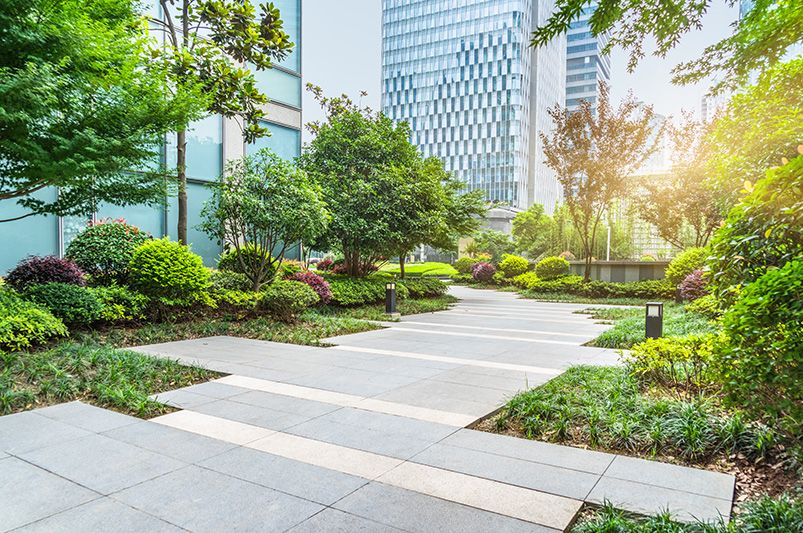In New York City’s competitive commercial real estate market, first impressions aren’t just important—they’re everything. Whether you own a retail storefront, an office building, or a mixed-use property, the exterior sets the tone for how tenants, customers, and partners perceive your space. Strong curb appeal communicates professionalism, safety, and value before anyone even steps inside. In a city where foot traffic and visual impressions drive business, investing in curb appeal isn’t cosmetic—it’s strategic.
First Impressions Drive Traffic and Tenancy
NYC’s density means potential customers and tenants make fast decisions based on what they see from the sidewalk. A clean façade, well-maintained entryway, and attractive signage immediately signal that a property is well cared for. Conversely, peeling paint, dirty windows, or overflowing trash can suggest neglect, making people less likely to walk in or inquire about available space.
For commercial landlords, curb appeal directly impacts leasing success. Prospective tenants often judge a building’s quality by its exterior. If the outside looks neglected, they may assume the same about interior maintenance, HVAC reliability, or management responsiveness. Investing in a polished exterior helps attract higher-quality tenants who are willing to pay premium rents for a property that enhances their own brand.
Curb Appeal Reflects Brand Identity
Commercial properties don’t just house businesses—they shape the identities of those who operate within them. A well-kept building sends a message of trustworthiness and professionalism, which benefits every tenant inside. Office tenants want their clients to be impressed when they arrive. Retailers want passersby to feel invited to step inside. A clean, organized, and attractive exterior helps all tenants reinforce their own brand standards.
For owners and managers, curb appeal is a form of passive marketing. Even when spaces aren’t actively being shown, passersby notice buildings that look modern, clean, and well-lit. That recognition keeps your property top-of-mind for future leasing opportunities.
Safety and Cleanliness Increase Foot Traffic
In NYC, where pedestrian activity fuels commercial success, a clean and safe exterior directly correlates with customer behavior. Well-lit entrances, tidy sidewalks, and clear wayfinding create a welcoming environment. This is especially important for retail storefronts, restaurants, and service-based businesses that depend heavily on walk-ins.
Cleanliness also improves perceived safety. Graffiti, debris, and damaged surfaces can deter visitors and even attract vandalism or loitering. Regular maintenance such as power washing, graffiti removal, and litter pickup, can reduce these risks and make customers feel more comfortable approaching your building—especially during evening hours.
Enhances Property Value and Long-Term ROI
Curb appeal is one of the most cost-effective ways to improve property value. Small updates—fresh paint, clean awnings, updated lighting, or well-maintained landscaping—can significantly increase a building’s marketability. When prospective buyers or investors assess a property, its exterior condition plays a major role in perceived value and future maintenance needs.
For owners planning future renovations or expansions, maintaining strong curb appeal ensures the building never falls so far behind that costly corrective work becomes unavoidable. Regular upkeep reduces long-term expenses—proving that curb appeal is both smart and financially sound.
Supports Environmental and Sustainability Goals
Modern NYC tenants increasingly look for sustainable and eco-conscious properties. Elements like greenery, efficient outdoor lighting, and clean, recyclable waste stations signal that a property is aligned with environmentally friendly practices. Even small touches—such as planters with native plants or solar-powered exterior lights—can boost your building’s image and appeal to eco-savvy tenants.
How to Improve Curb Appeal in NYC
A strong curb appeal strategy doesn’t require a dramatic overhaul. Here are practical steps every commercial property owner can take:
- Routine exterior cleaning: Power washing, window cleaning, gum removal, and trash pickup keep your property spotless.
- Exterior repairs: Fix cracks, damaged signage, loose handrails, chipped paint, or worn awnings promptly.
- Lighting upgrades: Bright, energy-efficient lighting enhances visibility, safety, and nighttime appeal.
- Landscaping and planters: Even simple greenery softens the urban environment and makes entrances more inviting.
- Seasonal maintenance: Snow removal, leaf cleanup, and holiday décor keep your exterior attractive year-round.
- Updated signage and branding: Modern, readable, well-lit signs make a major impact on perception.
Conclusion
In NYC’s fast-paced commercial landscape, curb appeal isn’t optional—it’s essential. A clean, well-maintained exterior improves tenant satisfaction, attracts customers, increases leasing success, and boosts long-term property value. By investing in exterior upkeep and thoughtful design, commercial property owners can set their buildings apart from the competition and create an environment where businesses—and people—want to be.

